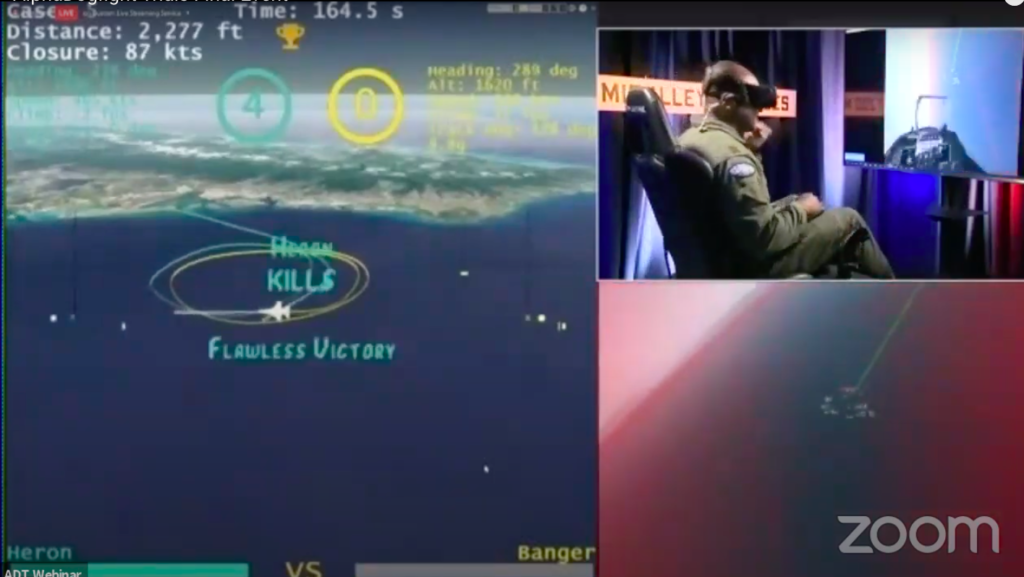By THERESA HITCHENS
 WASHINGTON: In a 5 to 0 sweep, an AI ‘pilot’ developed by Heron Systems beat one of the Air Force’s top F-16 fighter pilots in DARPA’s simulated aerial dogfight contest today.
WASHINGTON: In a 5 to 0 sweep, an AI ‘pilot’ developed by Heron Systems beat one of the Air Force’s top F-16 fighter pilots in DARPA’s simulated aerial dogfight contest today.
“It’s a giant leap,” said DARPA’s Justin (call sign “Glock”) Mock, who served as a commentator on the trials.
AI still has a long way to go before the Air Force pilots would be ready to hand over the stick to an artificial intelligence during combat, DARPA officials said during today’s live broadcast of the AlphaDogfight trials. But the three-day trials show that AI systems can credibly maneuver an aircraft in a simple, one-on-one combat scenario and shoot its forward guns in a classic, WWII-style dogfight. On the other hand, they said, it was an impressive showing by an AI agent after only a year of development. (As I reported earlier this week, the program began back in September last year with eight teams developing their respective AIs.)
Heron, a small, female- and minority-owned company with offices in Maryland and Virginia, builds artificial intelligence agents, and is also a player in DARPA’s Gamebreaker effort to explore tactics for disrupting enemy strategies using real-world games as platforms. The company beat eight other teams, including one led by defense giant Lockheed Martin — which came in second in the AlphaDogfight “semi-finals” that pitted the AI pilots against each other this morning.
Heron’s team did a live-stream Q&A on Youtube. “Even a week before Trial 1, we had agents that were not very good at flying at all. We really turned it around, and since then we’ve been really number one,” said Ben Bell, Heron’s co-lead for the project. The team intends to publish later this year some of the details about its reinforcement learning process for the AI, he said.
The trials were designed as a risk-reduction effort for DARPA’s Air Combat Evolution (ACE) program to flesh out how human and machine pilots share operational control of a fighter jet to maximize its chances of mission success. The overarching ACE concept is aimed at allowing the pilot to shift “from single platform operator to mission commander” in charge not just of flying their own aircraft but managing teams of drones slaved to their fighter jet. “ACE aims to deliver a capability that enables a pilot to attend to a broader, more global air command mission while their aircraft and teamed unmanned systems are engaged in individual tactics,” the ACE program website explains.
Heron Systems’ AI was extremely aggressive in the games, with its AI pilot consistently able to turn and score killing hits on the simulated F-16 piloted by an unnamed Air Force pilot, with the call sign “Banger,” a graduate of the Air Force’s highly selective Weapons School at Nellis AFB. The AI exhibited “superhuman aiming ability” during the simulation, Mock said.
While the trials were not in anyway “definitive” of an AI pilot’s future capabilities or even its viability, Mock said, at the same time “what we saw was that in this limited area, in this specific scenario, we’ve got AI that works.”
DARPA intends to take the simulator used in the trials, and the simulations, to Nellis, where other Air Force pilots can take a stab at trying to beat AI pilots. Next steps will be to move on to testing AI pilots’ capabilities to perform other types of aerial combat missions.
Somewhere, the infamous Red Baron is no doubt laughing in amazement.
No comments:
Post a Comment